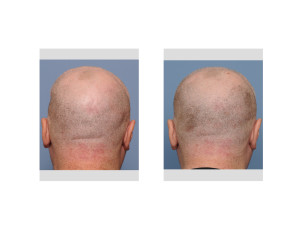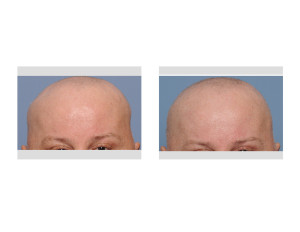Background: The external shape of the head is a direct reflection of the form of the skull underneath it. While skulls can have various sizes and are made up of multiple cranial bones, a smooth and convex shape is desired no matter from what angle it is viewed.
Men make up a greater portion of skull reshaping patients than women. This is a direct result of exposed scalp surfaces from men who have shaved their head or have little hair density or length to cover it. Women can better camouflage skull irregularities because of their usually better hair density and growth.
Prior skull surgery or cranioplasty efforts can leave a skull shape that is asymmetric or irregular. While the skull surface may appear smooth at the time of surgery, healing and scalp adaptation may eventually reveal even the most minor skill irregularities.
Case Study: This 45 year-old male presented with a desire to improve the shape of his head. He had a history of prior skull surgery and cranioplasty efforts, of which the initial origin of these efforts remained unclear. He reported that ‘bone cements’ had been used in the past.
Under general anesthesia and through his existing coronal scalp incision from ear to ear, his entire skull surface was exposed. There was a form of bone cement (which appeared to be Kryptonite from my experience) at various locations on his skull. Its application was irregular and not smoothly applied. A handpiece and burr was used to reduce and smooth out all existing bone cement areas. Application of new bone cement (PMMA) was used to fill in any depressed skull areas.

Highlights:
1) The shape of the head should be smooth and convex from all viewing angles.
2) Many skull contour irregularities can be satisfactorily treated by the application of bone cements
3) There are different types of bone cements used in cranioplasty which differ in material and cost but not in effect.
Dr. Barry Eppley
Indianapolis, Indiana



